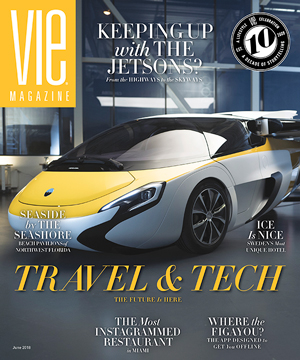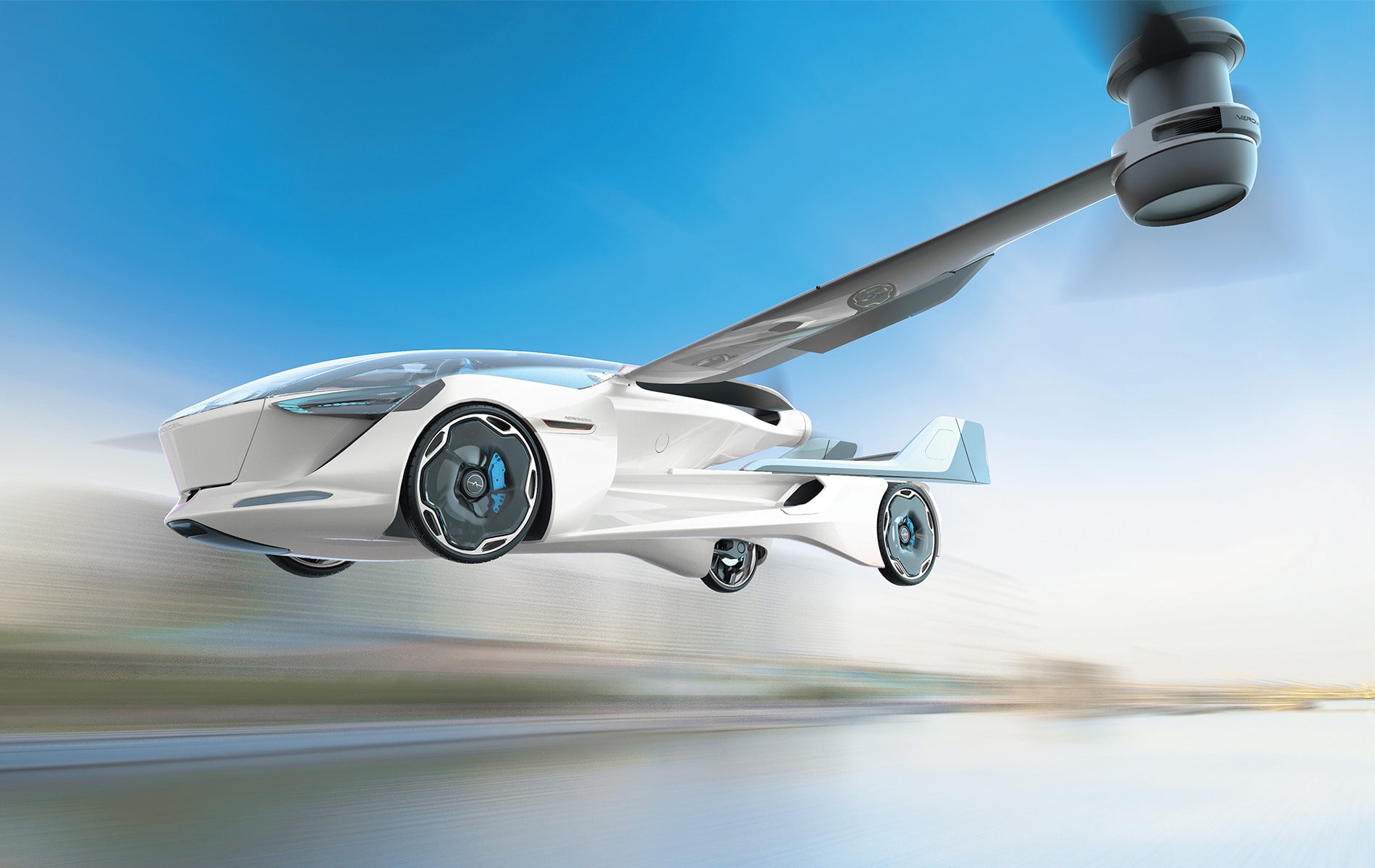
vie-magazine-ev-revoution-hero-min
The AeroMobil 5.0 VTOL—This four-seat concept has two electrically driven rotors for vertical takeoff with horizontal thrust from an electric-powered rear-mounted pusher propeller. Each occupant will have a personalized in-flight experience, with flight or drive data, and advanced communications and media to ensure occupants stay connected while in the air or on the road. The company expects the AeroMobil 5.0 to be available within seven to ten years, in line with the reality of building and scaling the infrastructure and regulation for such innovative personal transportation. Artist rendering courtesy of AeroMobil.
Keeping Up with the . . . Jetsons?
From the Highways to the Skyways
By Gerald Burwell
In 1962, Hanna-Barbera’sThe Jetsons portrayed the typical American nuclear family of the sixties: a hardworking husband with his loving wife and two well-behaved children, a live-in maid, and, of course, the family dog. Only it wasn’t the 1960s—it was the 2060s, the maid was a robot, and George commuted to his job in a sleek antigravity aerocar. Though there hasn’t yet been a breakthrough in antigravity, advances in technology are propelling the concepts of personal travel—some of which would be considered by most as superfuturistic—to within a decade (or sooner) of becoming a reality. Between advancing technologies and the growing global concern to reduce greenhouse gases, the world is on the verge of witnessing a sea change in both the automotive and personal air travel industries.
Drivers, start your engines.
In 1808, the first “car” was little more than a horseless carriage, and the next eighty years saw several crude variations along the way. Propulsion systems were just as crude and ranged from electric, steam, and combustion engines of diesel, gasoline, and hydrogen. The first marketable automobiles in the late eighteen hundreds were German and French. The cost of these handcrafted machines made them accessible only to the wealthy. With the advent of the mass-produced car around 1905, the middle class was granted an affordable mode of transportation that presented new opportunities—both business and social.
A hundred years later, humanity is about to be hurtled into yet another transportation revolution, and the combustion engine is not in the picture. Huge advances in technology are allowing man to begin to think outside of the box—and in some cases, way out of the box. With help from affordable, lighter, more powerful, and longer-lasting batteries, the unbelievable is now achievable.
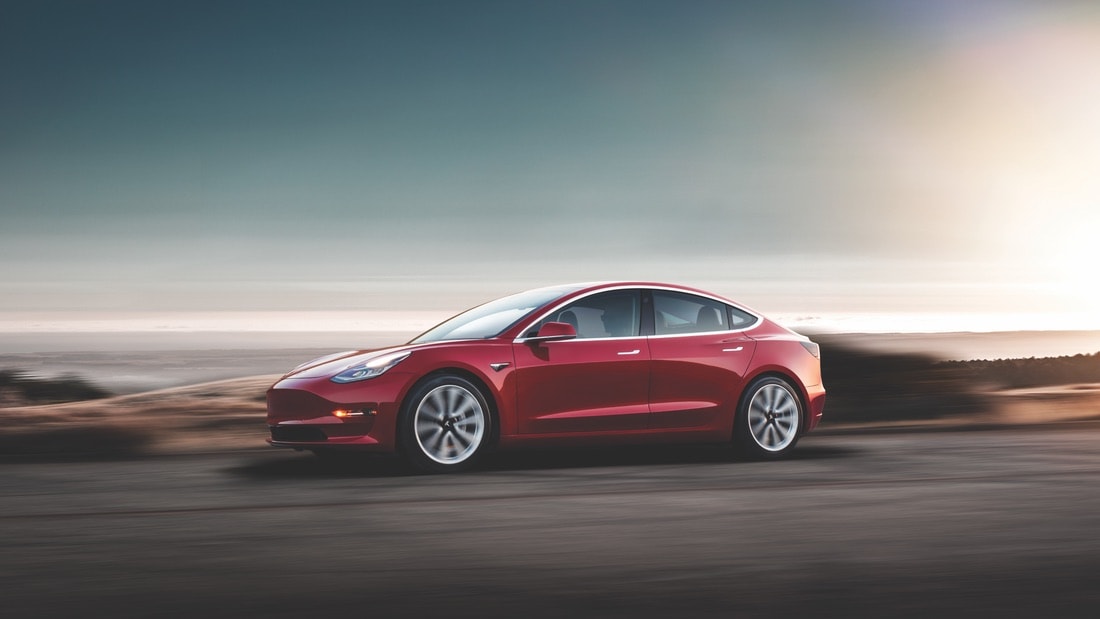
Tesla’s Model 3 is a premium midsize high-performance sedan that can carry five adults, do 0–60 mph in five seconds, and has an all-wheel-drive option and a maximum range of 310 miles. If Tesla can survive the production woes that it is currently experiencing with the Model 3, the car will be the automaker’s golden goose.
Photo courtesy of Tesla
The mother of invention.
What may shock some is that the hybrid car—having a propulsion system of both electric motors and an ICE (internal combustion engine)—dates back to 1898 and Dr. Ferdinand Porsche’s P1. With an impressive range of about forty miles, it had four electric motors (one at each of its four wheels) that received electric power via a small onboard ICE generator. What may be equally surprising is that in Dr. Porsche’s era, the electric-powered car was preferred by consumers; they were quiet, they did not emit offensive exhaust, and they did not have cantankerous, gearboxes like those found in their gasoline-powered counterparts. But within a few years’ time, the limited range of the electric car was incapable of meeting the needs of the populace who wanted to travel farther and faster, giving way to the gasoline ICE as the preferred power plant by the automobile manufacturer.
The hybrid made a resurgence in the mid-sixties when the US federal government was attempting to reduce air pollution, and then again in the early and late seventies with two oil embargoes that caused economy-crippling fuel shortages. Despite higher prices at the pumps following each crisis, plentiful gas supplies prompted interest in the hybrid to fade. But Japanese and European automakers continued development efforts in response to higher fuel prices elsewhere in the world. Hybrids like the Prius began to make their way into the world markets in 2000, with environmentally conscious consumers being the typical US buyers; the cost of the battery components inflated sticker prices, however, and dampened consumer interest. Ironically, all the reasons the original hybrid was both liked and disliked remained consistent to majority opinion 120 years later.
But wouldn’t it be great to eliminate the car’s carbon footprint altogether? That’s what the state of California thought when it adopted the Zero Emission Vehicle (ZEV) rule in 1990. This bill, along with the introduction of other federal clean-air acts, would push automakers to revive efforts to produce a viable plug-in electric vehicle (EV). In 1996, General Motors was the first with the EV1—a futuristic-looking package designed from the ground up. GM leased it through a special program, allowing the automaker to retain ownership and thus ultimately control the fate of each car. In 2003, despite considerable backlash from lessees, GM made the controversial decision to recall and destroy all 1,100 EV1s (except for a few dozen “deactivated” units), which caused considerable debate as to the automaker’s motive behind canceling the program.
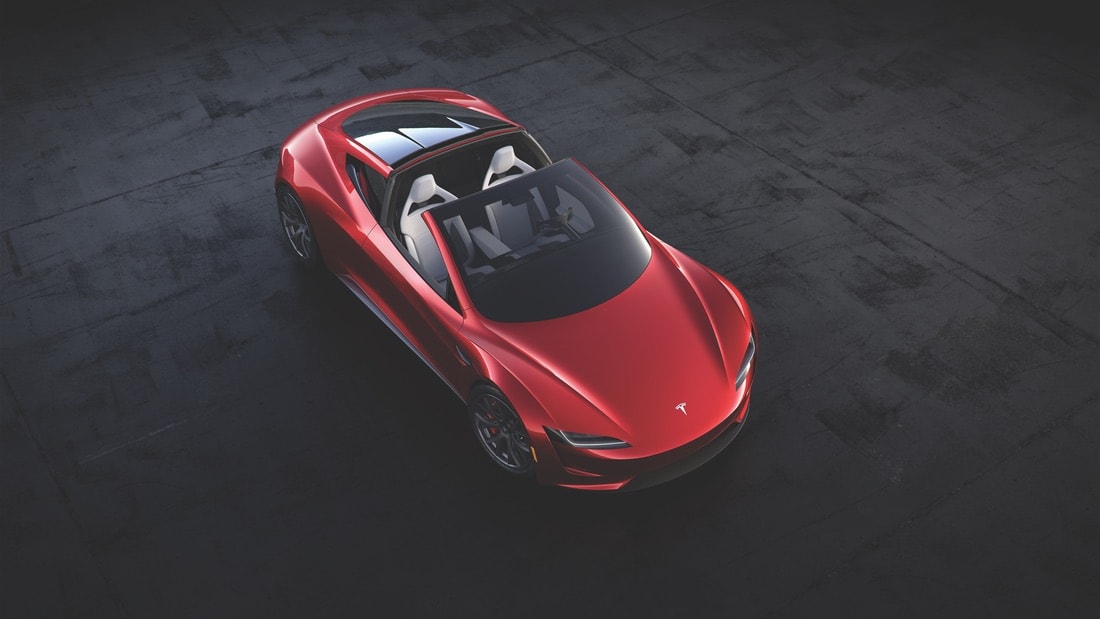
Brawn and beauty: With the Roadster, Tesla claims another first—producing a record-setting supercar with stunning looks and room for four passengers. At 0–60 mph in 1.9 seconds, it is currently the quickest on the planet. It has other incredible stats, such as all-wheel drive, a top speed of 250+ mph, and a range of 620 miles. Its price tag of $250,000 is a bargain in comparison to the competition.
Photo courtesy of Tesla
One person to take note was SpaceX’s CEO, Elon Musk, who immediately took up the torch for jilted EV1 customers by promising to deliver an all-electric vehicle the likes of which the world had never seen. A decade later, in 2012, Musk delivered on his promise with the full-size luxury Tesla Model S sedan, and then again with the 2015 Model X SUV. With the Model S and Model X having been brought to market, Tesla was recognized as the first carmaker to finally give customers an all-electric option that had both performance and range—and with exceptional looks to boot. World confidence in the new automaker was overwhelming in March 2016 when over 325,000 reservations were procured for the Model 3 within a week of Tesla opening sales. If production hurdles can be overcome in the coming months, Tesla has high hopes for the $35,000 midsize to be the impetus to push the ICE car market over the proverbial cliff and into the EV revolution. The company’s many other developments include the heavy-duty Semi, the crossover Model Y, and the hyperperformance Roadster, which are all due out by 2020.
Whether Tesla is successful or not in pulling off their coup, there have been other significant milestones in the last ten years that are helping to energize the EV tidal wave. Necessity is the mother of invention, as the saying goes.
The problem: environmentalists project that if the growth of greenhouse gases continues, it could be the tipping point to cause irreversible damage to our planet’s climate systems.
The solution: eliminate as many sources of man-made greenhouse gases as possible—primarily the internal combustion engine. Since 15 percent of the world’s man-made carbon dioxide is produced by transport vehicles (cars, planes, ships, etc.) powered by fossil fuels, the ICE was clearly in the crosshairs of climate change organizations.
Environmentalists project that if the growth of greenhouse gases continues, it could be the tipping point to cause irreversible damage to our planet’s climate systems.
In 2017, of the countries that were already committed to reducing greenhouse emissions, a handful made further landmark pledges to ban the sale of ICE vehicles: Norway by 2025; India by 2030; China by 2035; and the UK and France by 2040. Eight additional countries have set similar goals with others likely to soon join rank. The United States has yet to set a policy. In fact, this past March, the administrator of the EPA, Scott Pruitt, was swimming upstream with the decision to roll back emissions policies that had been set by the previous administration. History will tell how long the US can remain an island while the rest of the world sails on toward improving the global environment. Despite the absence of leadership from the federal government in this department, eight states have adopted policies to ban fossil-fuel vehicles by 2050, with California leading the pack with the most aggressive goals.
These imminent deadlines act as convincing persuaders for automakers to produce an inventory of zero-emission vehicles. This challenge is no small feat: production lines are predominantly tooled for ICE vehicles, and Tesla has yet to prove that it’s capable of producing an entire lineup of all-electric vehicles. Regardless of the daunting nature of the challenge, determined entrepreneurs are being drawn like moths to a flame.
The EV revolution is here.
So who is lining up for the challenge? After all, those that achieve success in producing a marketable EV are guaranteed a place at the table with a growing customer base. In a paper published in July 2017, the research firm Bloomberg New Energy Finance (BNEF) predicted that as the cost of battery technology continues to drop, the percentage of EVs on the road will climb exponentially from less than 1 percent in 2016 to about 54 percent by 2040—a more than 5000 percent increase in a relatively short period.
Of course, Tesla has established itself as the leader. But there are dozens that are clambering right behind them. Ironically enough, but not surprising, of Detroit’s Big Three, GM appears to be at the forefront with a clear intention to plow full steam ahead; they plan to have twenty gas-free models by 2023. Ford announced this past January that it was doubling their R&D spending toward EVs, with a promise of forty electric vehicles by 2022.
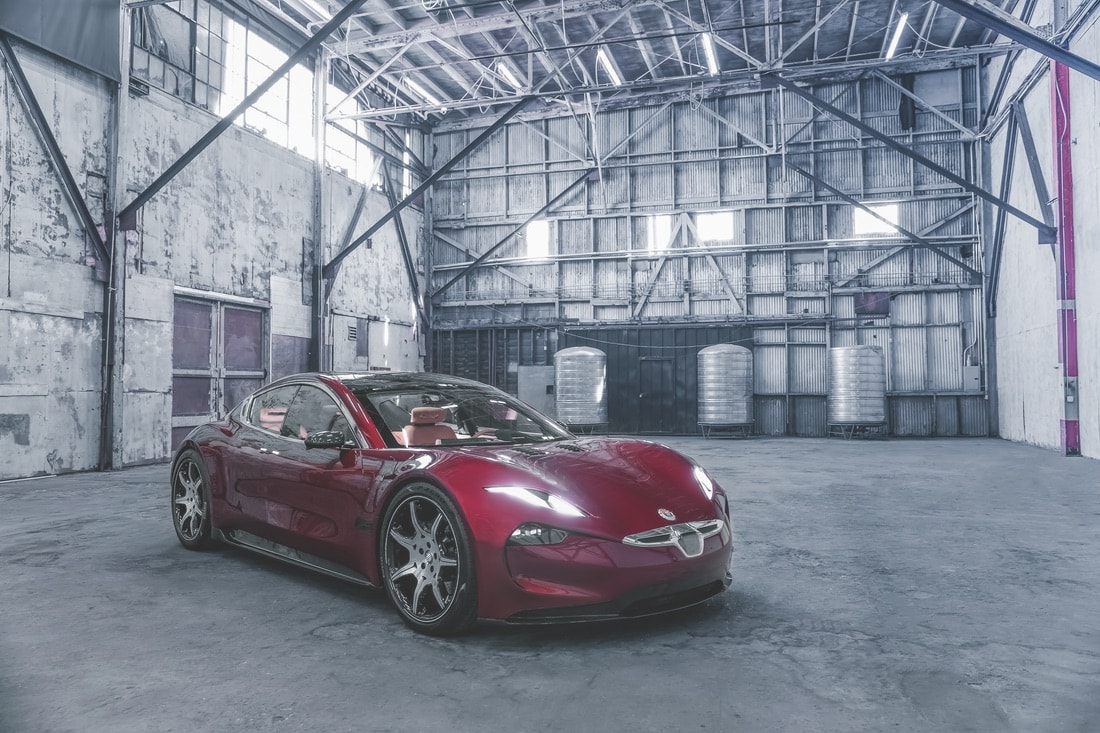
In January, Fisker unveiled the gorgeous 2019 EMotion. Starting at $130K, this all-wheel-drive luxury sports sedan can go 0–60 mph in under three seconds, has a top speed of 160 mph, and a range of four hundred miles. One of its most appealing features is the ability to get an additional 125-mile charge in as little as nine minutes.
Photo courtesy of Fisker, Inc.
What about Chrysler? In a September 2016 interview with Car magazine, Fiat Chrysler Automobiles (FCA) CEO Sergio Marchionne expressed that there isn’t any profit margin in electric vehicles and that not enough exploration had been done for an alternative fuel base. At the time, FCA was the only major player in the automotive industry to take such a stance. Fast-forward one and half years later to January 2018, Marchionne was suddenly changing gears with the announcement that Alfa Romeo and Ferrari will both have electric vehicles on the way by 2020. The reason for the one-eighty decision to finally go electric may be powered elsewhere than by Marchionne, who has decided to step down as CEO starting in 2019.
On the flip side, literally every other automaker in the world is fully invested in the future of electric vehicles. Volvo is currently on track to be the first major automaker to transform their lineup to completely all-electric by 2019, and Jaguar Land Rover is determined to do the same by the following year. And, it’s not just the big-name players. By gutting the complicated internal combustion engine with its fuel delivery and exhaust systems, the entire status quo of the car industry has been simultaneously ripped apart. With the evolution of the car’s drive system to less-mechanical components of batteries, electric motors, and software, the car has more or less evolved into a giant tech gadget. In fact, unlikely players are seemingly coming out of the woodwork, including Dyson—yes, the company that turned the household vacuum industry on its ear is now throwing the dice at the EV table.
Following suit to Tesla is Fisker Automotive—another California-based company, founded in 2007 by Henrik Fisker. The 2012 Karma was the company’s first debut off the line, but it fell on deaf ears, probably due to the roaring success of Tesla’s Model S that same year. But the veteran Fisker chalked it up to experience and moved on to the next challenge—the EMotion—which he unveiled this past January. Due out in late 2019, the EMotion promises to raise the bar of current lithium-ion battery technology with increased range and quicker charge times. Fisker also announced the filing of patents for a solid-state graphene battery due out after 2023, which is projected to increase the range further by at least 25 percent, get lightning-fast full charges in as little as one minute, and drop costs substantially.
No matter if it is for land, sea, or air—the success of an electric vehicle will boil down to finding the perfect balance in the cost of battery technology, performance, and range. With the inevitable victory of the electric vehicle on the horizon, so comes ingenuity to harness the potential to monetize a new industry segment—autonomous vehicles.
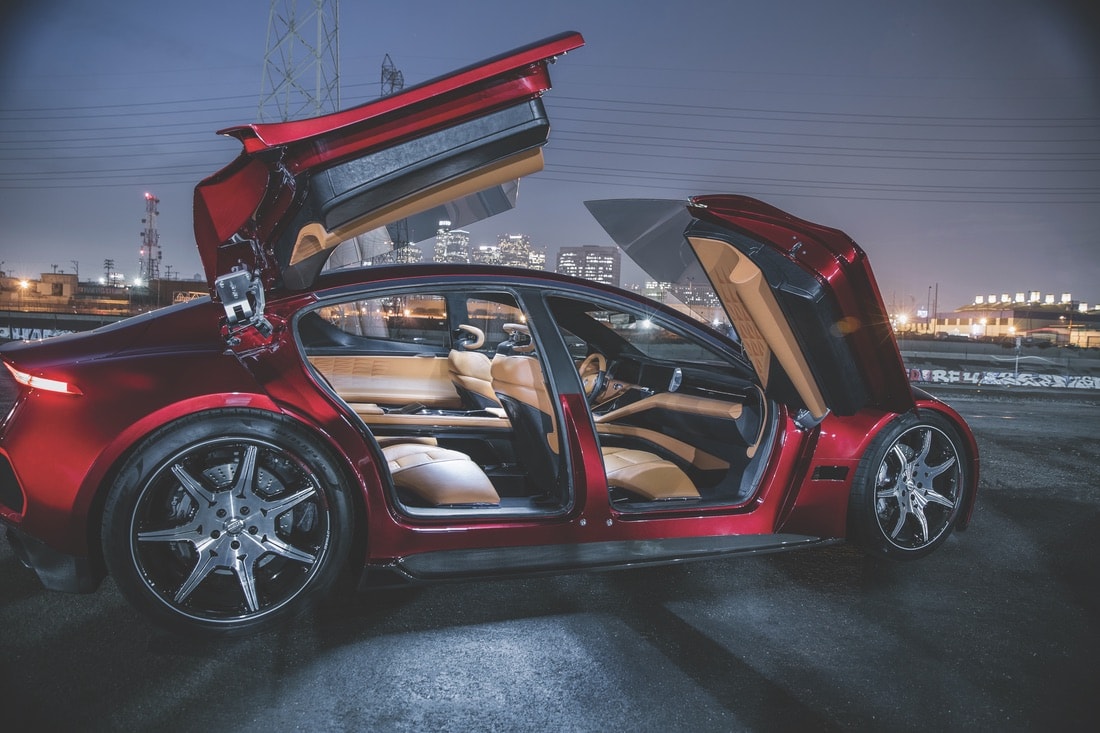
EMotion’s illuminated flush touch handles open butterfly doors to expose an interior that defines the future of luxury, including ultrasoft premium leather (a vegan option is also available). Conveniences include luxurious seating for four (five with optional rear bench seat), inductive charging ports and personal holders for four smartphones, and individual four-zone adjustable electrochromic tinted glass roof.
Photo courtesy of Fisker, Inc.
Look, Mom . . . No hands!
Variants of a self-driving car have been explored since about 1925; however, all versions—whether operated by remote control, by computer control, or with the assistance of buried wire—required some human input. If not for the advancement of several other technologies, such as GPS navigation, cameras, radar, lidar, mapping and data management, computing power, and AI (artificial intelligence) software, the autonomous car would not be a possibility.
Significant advancements were achieved by mostly European engineers between the late eighties and early 2000s. But most autonomous systems currently in development are very similar to that developed by a group of Stanford University engineers, which, in 2005, was the winning team among five finalists of the DARPA Grand Challenge. “Stanley”—a VW Touareg adapted with sophisticated sensors and computing equipment—navigated the 132-mile Mojave Desert off-road course autonomously in the quickest time and without incident.
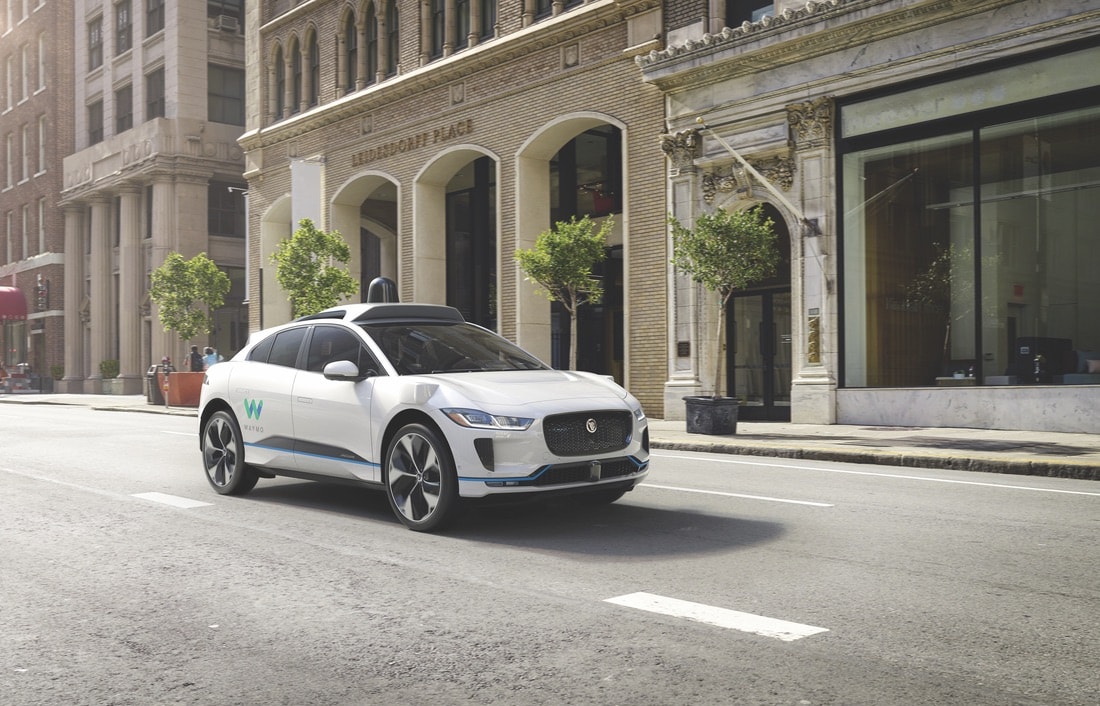
The self-driving Waymo Jaguar I-PACE: This long-term collaboration will further Waymo and Jaguar Land Rover’s shared goals. To date, Waymo is the only company with a fleet of fully self-driving cars on public roads. Waymo will soon launch the world’s first self-driving transportation service, allowing the public to use Waymo’s app to hail a vehicle.
Photo courtesy of Jaguar Land Rover
Scrambling to be the first to bring a reliable, fully-autonomous system online, automakers have either been partnering with or outright buying companies with patents that specialize in the technology necessary to achieve success. This approach ultimately leapfrogs the R&D and cuts years from the process. The reward to be the first to cross the finish line is a payoff that is certain to be multifaceted and lucrative. It seems that they can’t throw money at it fast enough—investing tens of billions of dollars in the last decade.
It was 2009 when Google’s subsidiary outfit Alphabet announced the debut of Waymo—their autonomous vehicle project. It was no small surprise to learn that at the helm of the project was Sebastian Thrun, who was the project lead for “Stanley.” Waymo’s autonomous system has seen almost ten years of testing, having been retrofitted onto various car platforms including Audi, Chrysler, Lexus, and Toyota. It has evolved into an incredibly sophisticated $150,000 system, and, as of this past March, Waymo has partnered with Jaguar to take the system into production in up to twenty thousand autonomous versions of Jaguar I-PACE electric vehicles by 2020.
When the race to perfect autonomy began, Tesla was in the midst of developing the Model S. With the technology and demand for self-driving cars just around the corner, Elon Musk had the vision and foresight to understand that the basis of the future car would hinge greatly on software and the ability for instant updates. So, much like the smartphone, a Tesla can receive software updates from a dedicated network via a satellite link, a practice that appears will be the norm with all autonomous vehicles. According to the automaker, every Tesla built after October 19, 2016, possesses the hardware necessary for fully autonomous driving, but Level 2 autonomy is the highest level achievable with the current software.
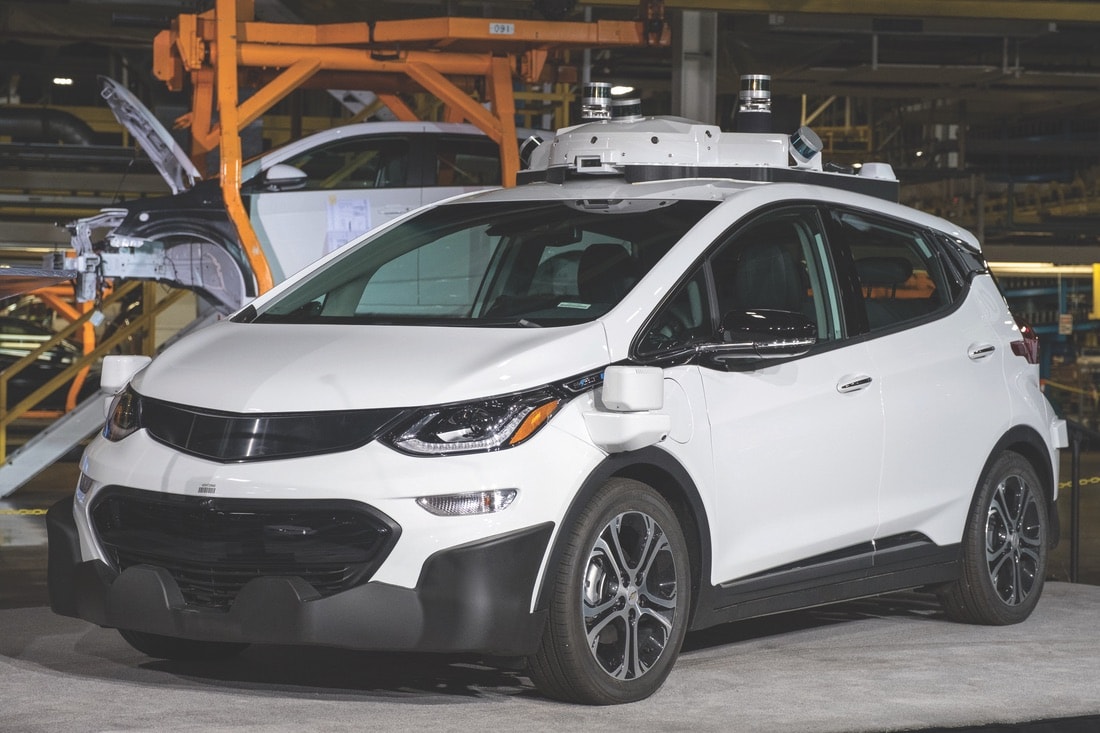
In January, General Motors announced completion of testing two hundred Chevrolet Bolt EV vehicles equipped with its next generation of self-driving technology and will begin commercialization of the autonomous platform in 2019, beginning with the Cruise AV.
Photo by Steve Fecht for General Motors
But GM was first to have a mass-producible, fully autonomous car. As of June 2017, the automaker had completed assembly of more than two hundred units of the Chevy Bolt EV incorporating the autonomous system developed by Cruise. The cars have been undergoing testing in Arizona, California, and Michigan, and this past January, the automaker announced that the self-driving platform would be commercialized in 2019, starting with the Cruise AV. GM estimates that by purchasing the tech start-up company Cruise two years ago, they were able to shave six years from the R&D process.
Being the first to the party gives GM some pretty exciting options. But if the music keeps changing as much as it has been, it might be a little tricky for GM to know the dance steps. Regardless, there will be others showing up soon—like GM, other automakers and tech companies are forming unusual alliances in search of a match made in self-driving heaven: Mazda and Toyota are joining forces in a partnership with Amazon; VW with chip giant NVIDIA; and Ford with Argo AI, an artificial intelligence start-up. Still, others are trying to do it on their own like Apple, Fisker, and Tesla—and there are many more. They just might have some great ideas on how to move to whatever groove is playing at the time. And the moves may not be limited to the dance floor—they may be flying overhead.
This is your captain speaking.
The idea of a flying car has existed since the dawn of the airplane. Dozens of designs filed with the United States Patent and Trademark Office (USPTO) have never seen the light of day. Only two designs ever had prototypes complete FAA certification, but they weren’t very practical, roadworthy vehicles. With improvements and declining costs of carbon fiber, batteries, and electric motors, there are now at least four versions of “roadable” flying cars that are currently in various stages of development and taking reservations.
The Uber of the skies is almost here, and like the automobile industry, the aeronautics industry is bracing for a shake-up in a big way.
The two-seat Transition, designed by the Boston-based company Terrafugia, is slated to deliver sometime in 2019. The $300K-plus roadable plane is technically categorized by the FAA as an LSA (light-sport aircraft), and it does not require the removal of wings or fuselage like its predecessors. Powered by a single ICE engine in both road and air configurations, the Transition is rated at 70 mph on the ground, and 110 mph in the air. Having the first practical vehicle to solve the challenge of the first-to-last-mile personal travel with a four-hundred-mile range is pretty cool. What isn’t so great is that the overall performance is not very attractive in either mode, its curb appeal takes some getting used to, and you need a runway to take off and land. Alternatively, Terrafugia is in the design stages of the more exciting sister project—the TF-X—a four-seat autonomous flying car with a range of five hundred miles and a 200-mph cruise speed. In contrast to the Transition, having two collapsible-propeller tilt-rotors mounted on the wing tips provides a vertical takeoff and landing (VTOL) capability, requiring only a fifty-foot pad for takeoff and landing. The company anticipates the delivery date to be around 2023 to 2025 and that its starting price will be in line with luxury cars.
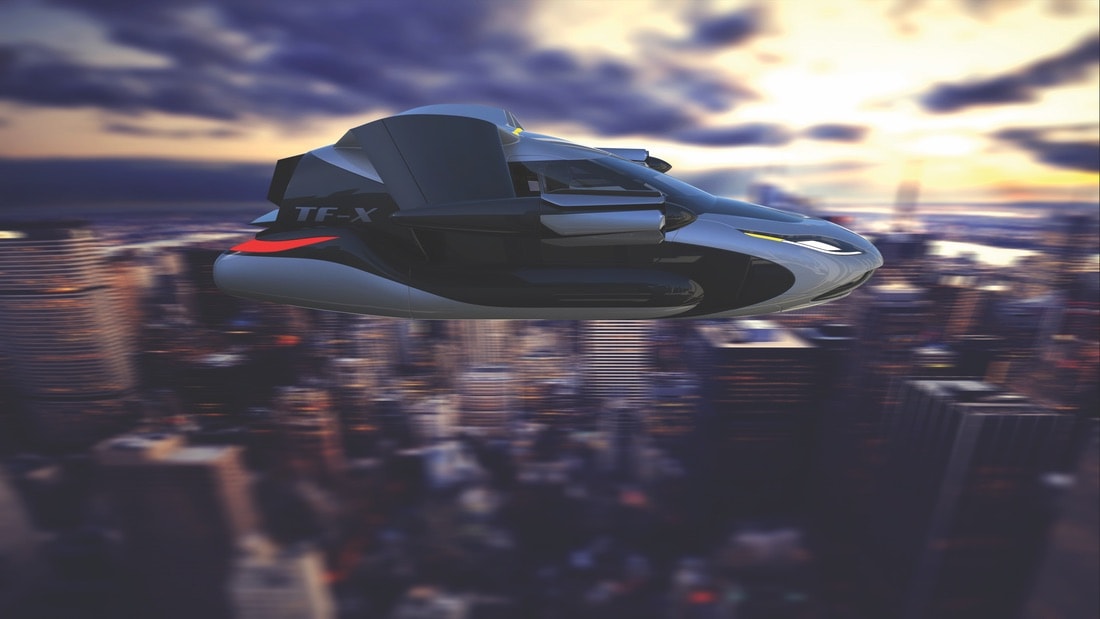
The TF-X by Terrafugia provides vertical takeoff and landing (VTOL) capability with highly reliable electric motors and custom-made quiet rotors to get you closer to your destination. The TF-X gets its power in forward flight from a powerful turbine engine. Get to your destination quickly, safely, and efficiently. The TF-X seats four and drives like a typical car. It will be fully street legal.
Photo courtesy of Terrafugia.
The Switchblade by Samson is another two-seater design with an ICE power plant for both drive and flying modes. The name is derived from the way its wings deploy from the undercarriage during the three-minute transition from drive to flight mode. The three-wheeled flying car is expected to reach maximum speeds of 100 mph, and 200 mph in drive and flight modes, respectively, and have a range of about 450 miles. According to the company designer and CEO, Sam Bousfield, the Switchblade will be sold as an experimental aircraft; it will not require FAA certification.
Slovakian-based AeroMobil has developed the two-seater AeroMobil 4.0 STOL (short takeoff and landing). Similar to the Transition and the Switchblade, the AeroMobil 4.0 receives its primary power from an ICE in both drive and flight modes but gets help from two electric drives for each front wheel while in drive mode. With attractive styling, the AeroMobil 4.0 is capable of respectable performance in both drive and flight modes. AeroMobil is accepting preorders for the $1.6M vehicle but has not yet announced a delivery date. The company also has an all-electric four-seater AeroMobil 5.0 VTOL in the works. And, like the TF-X, the VTOL capability requires only a small pad.
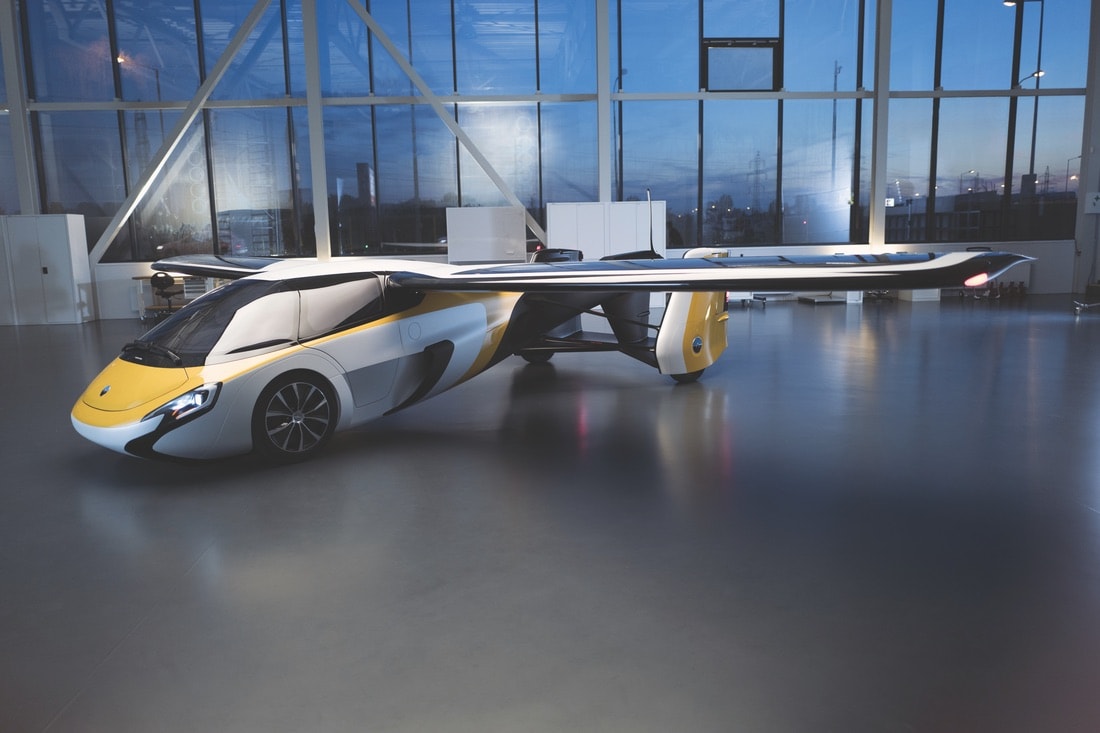
The two-seater AeroMobil 4.0 STOL has an ICE for both drive and flight modes and two electric motors for front-wheel drive assistance while on the road. It can go 0–60 in ten seconds and achieve a top speed of 100 mph. It takes a short three minutes to transition from drive to flight mode, flies at an impressive 225 mph with a push propeller configuration, and has an operating range of five hundred miles.
Photo by Mark Fagelson for AeroMobil.
The two-seat PAL-V Liberty, designed and produced by the Dutch company PAL-V International, is a little different in that when flying, it does not operate as a plane but as a traditional gyrocopter. However, it still requires a runway for takeoff and landing. Also, of all the vehicles in the review, the Liberty drives more like a motorcycle than a car. The $399K vehicle gets its power from a single 100 hp ICE, has a maximum surface speed of 100 mph, a maximum air speed of 110 mph, and a range of 310 miles.
Except for the AeroMobil 5.0 and the Terrafugia TF-X, these examples of flying cars do not have autonomous control and to operate them in flight will require a pilot license. With the considerable difficulty to obtain the necessary license in addition to the very steep costs of these vehicles, I do not foresee these flying off the production line (no pun intended). Besides, there is something else in development that could impact the future success of the flying car.
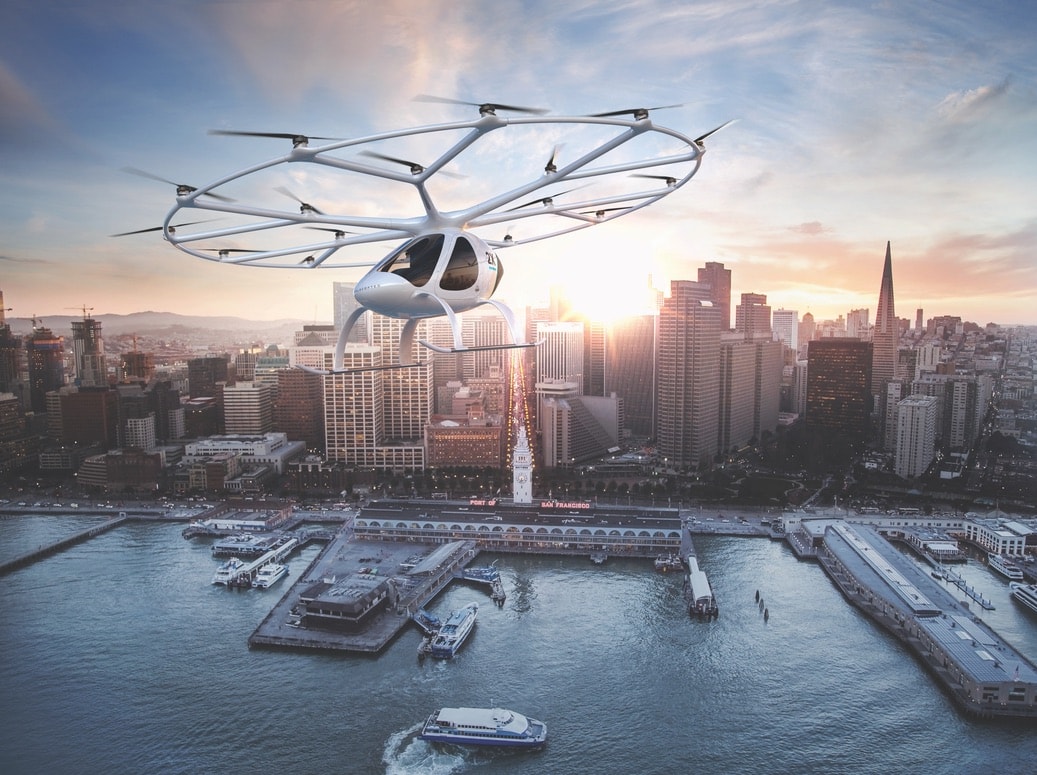
On April 17, Volocopter presented its air taxi infrastructure for cities. The vision integrates air taxis into existing transportation systems and provides additional mobility for up to ten thousand passengers per day with a single point-to-point connection. Cofounder Alex Zosel expects the first full Volocopter air taxi systems with dozens of Volo-Hubs and Volo-Ports to be in place within the next ten years, capable of flying one hundred thousand passengers an hour to their desired destinations.
Photo courtesy of Volocopter.
It’s all in the prop.
The impact of the multirotor drone has been significant since its commercial arrival, thanks to its many applications—military, rescue, security, law enforcement, photography, and film—and soon it will probably explode the current commercial delivery distribution model. Though its emergence a decade ago seemed to be something novel, the basic design is a hundred years old. The original goal was manned flight, but available technology wouldn’t allow for stable piloting. It wasn’t until recently that a combination of lightweight components, along with inexpensive computing chips, gimbals, controllers, cameras, and, of course, lighter and longer-lasting lithium-ion batteries, allowed the prop drone to be controlled reliably and safely. By now, most of us have gotten used to the idea of drones roaming the countryside for aerial footage or carrying five-pound packages. But ride-hailing? You bet. The Uber of the skies is almost here, and like the automobile industry, the aeronautics industry is bracing for a shake-up in a big way.
It was only 2014 when the Chinese drone company Ehang introduced the battery-powered Ghostdrone—a compact and versatile camera drone that became a best seller among videographers. A short two years later, the company announced its plans to develop the all-electric Ehang 184 AAV (autonomous aerial vehicle), a single-passenger taxi drone to begin service with Dubai’s Roads and Transport Authority as well as the Nevada Institute for Autonomous Systems. Using a simple touch screen, the passenger programs the desired flight plan much like a smartphone navigation system, while actual piloting and flight controls are done via a computer-aided command center over a high-speed network. The 184 has not yet completed the testing phase, and the exact launch date of the taxi service in either Dubai or Nevada is yet to be announced.
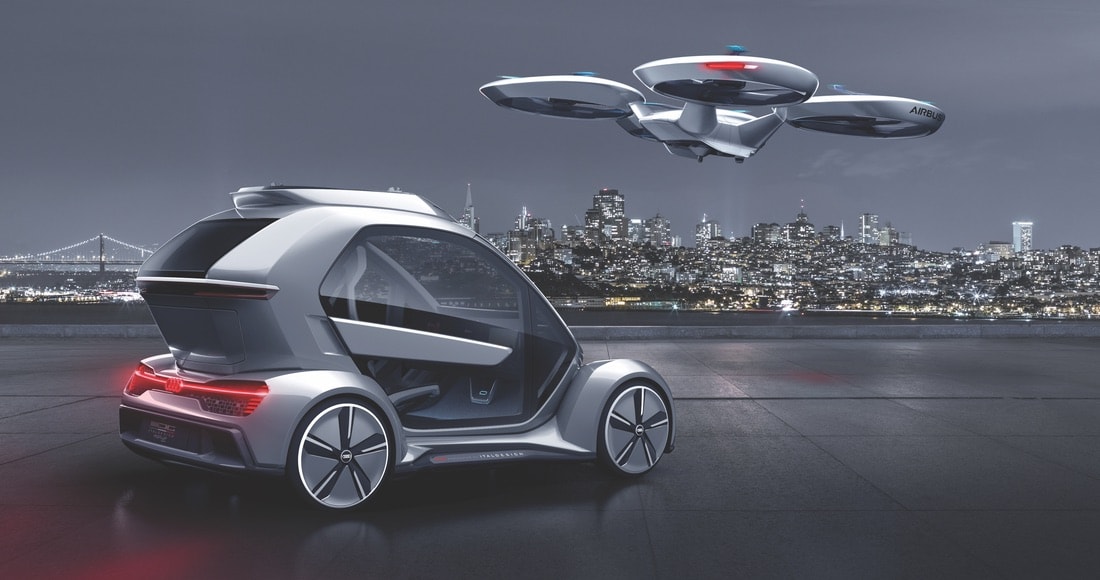
At the Geneva International Motor Show from March 8 to 18, Audi, Italdesign, and Airbus presented Pop.Up Next, an entirely electric, fully automatic concept for horizontal and vertical mobility. In the distant future, this vehicle could transport people in cities quickly and conveniently on the road and in the air, helping to solve traffic problems. The dominant interior feature is a forty-nine-inch screen, and the interaction between humans and the machine is performed by speech and face recognition, eye-tracking, and a touch function.
Photo courtesy of Italdesign, Airbus, Audi.
Daimler joined the passenger drone race by backing the tech start-up Volocopter in 2017. The aircraft designer flew their first single-seat prototypes, VC1 and VC2, as early as 2011. Significant strides were made with the introduction of the more sophisticated two-seat VC200 in 2013, which, after completing testing, was redesignated as the 2X. As of April 2018, the 2X is the world’s first manned multirotor electric copter to go into production. On a full charge, the aircraft can carry a maximum payload of 350 pounds at a maximum speed of 60 mph at 6,500 feet and has an optimal range of seventeen miles. The Volocopter 2X is also planned to participate in air taxi service in Dubai.
At least three other major players in the industry have seen the future of ride-hailing with plans for aircraft: Google has partnered with start-up Kitty Hawk to develop Cora, an all-electric two-passenger air taxi (production date 2020); Aurora Flight Sciences, a Boeing company, has announced an all-electric air taxi of similar capabilities (production date 2020); but maybe one of the ultimate concepts for the future of ride-hailing under development is the Pop.Up Next—a joint venture between Italdesign, Audi, and Airbus. Pop.Up Next is an all-electric vehicle system that incorporates three modular components consisting of a two-person travel pod and two autonomously controlled power chassis—a multirotor drone chassis, and a four-wheeled car chassis. The passenger pod is interchangeable with both chassis, making it possible for passengers to travel comfortably on the ground, but in an instant, the pod can be disengaged from the wheel-based carriage and whisked off through the air by the propeller-driven VTOL unit and vice versa (no production date is slated).
But as much as people want to begin utilizing these amazing passenger drones, there currently isn’t a system in existence to keep them from running into each other.
Setting their sights to the sky, Toyota is partnering with the Japanese-based tech start-up Cartivator to develop the SkyDrive. If successful, the SkyDrive will be one of the most unique of any of the EVs—appearing more like a flying cycle than a car. Designed for only one person, it is an extremely lightweight three-wheeled chassis with a protective covering and four rotors mounted at the frame quadrants. With speeds of 90 mph and 60 mph on the ground and in the air, respectively, the SkyDrive will almost instantaneously transition from drive to flight modes while moving. Toyota is hoping to unveil the SkyDrive at the Tokyo 2020 Olympics opening ceremony and showcase the vehicle’s nimbleness while lighting the ceremonial torch.
Your route is being calculated . . .
When European and Asian governments made landmark decisions in 2017 to apply deadlines to the ban the ICE, they did so knowing that the technologies existed that were necessary to achieve a zero-emission vehicle. They also knew that, with effort, these vehicles could be made available to consumers at affordable prices. Oddly enough, the majority of the US population may not see the need for all-electric vehicles just yet. But if the federal government isn’t quite ready, they had better get prepared—it appears the rest of the world is determined to give them to us.
The developments covered in this article are only the tip of the iceberg. Technologies and situations are literally changing in the blink of an eye—whoever appears to be in the pole position one week may find themselves trailing by several positions the following week. There are considerable concerns and logistics that remain to be thought out. For instance, regulatory laws and safety requirements for the past hundred years have been established regarding vehicles and aircraft operated by humans, all of which will now have to be rewritten to account for autonomous computer operation.
Full autonomy in the transportation industry is about to have a profound impact on our future—and it is much closer than most realize.
In addition, the impacts of these industry changes are bound to have innumerable effects that are likely to spread throughout our society. No one can be certain as to what these effects will be or to what magnitude, but there has been considerable speculation. For example, new technology may require improvements to road and air travel support infrastructures, but because of improved travel efficiency, possibly less infrastructure will be required. Or, with autonomous ride-hailing and sharing becoming more prevalent, large parking areas at retail and office buildings may become a thing of the past. And, more lives will be saved by removing human operator error, which is a positive benefit, but it will have an adverse effect on current organ donor programs.
If ride-hailing services like Uber and Lyft are big successes now, their success would be exponentially higher with superefficient autonomous vehicles that remove the bad and undisciplined driving habits inherent in human operation. These companies would not be the only ones to benefit; public welfare improvements would include vehicles that are more safely operated and consume less energy. Entire municipalities that suffer from overly congested streets and wasted fuel are eager for relief—relief that autonomy could deliver.
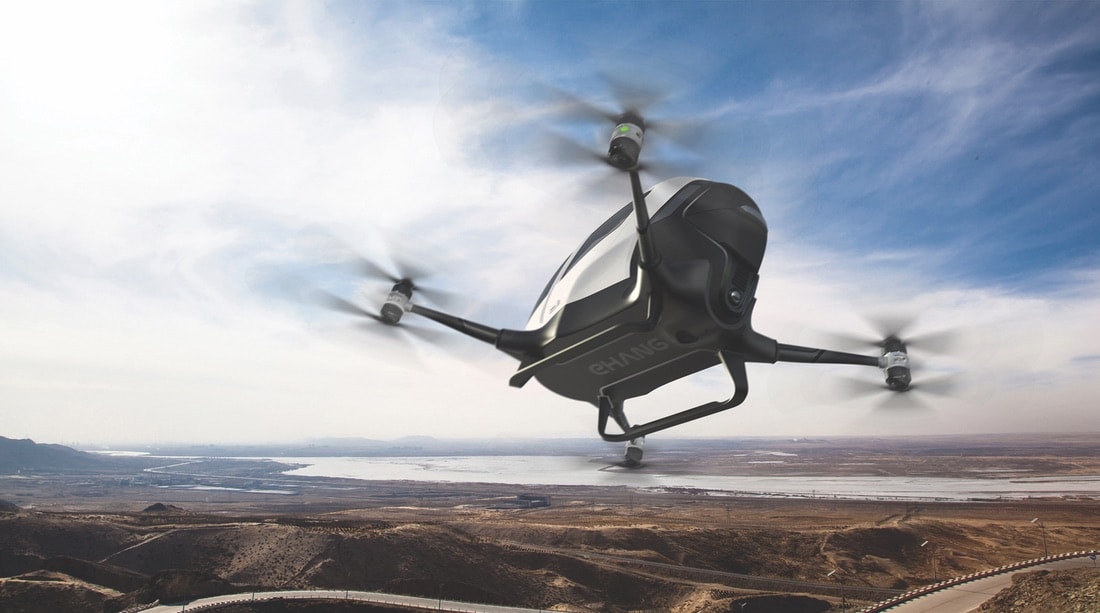
In 2016, Ehang announced plans to develop the all-electric Ehang 184 AAV (autonomous aerial vehicle), a single-passenger taxi drone. The 184 will carry a total payload of 220 pounds at 60 mph for up to twenty-five minutes.
Photo courtesy of Ehang.
No matter the concerns, like the technological hurdles that are being conquered today, pure necessity will cause problem solving to come sooner rather than later. Entire municipalities have already begun preparations to embrace autonomous travel. The ultramodern city of Dubai in the United Arab Emirates is one such city to take on the challenge with gusto; they are on an aggressive track to have 25 percent of all passenger trips within the city to be via autonomous all-electric travel by 2030. All types of ride-hailing companies—for both ground and air—have been more than eager to participate; these include Ehang, Fisker, Nissan, Tesla, Uber, Volocopter, and many more. Other cities around the world—including in the US—have similar plans but are currently a decade or more behind Dubai.
No one has recognized the potential of autonomous vehicles more than Uber. Last year, the ride-hail giant formed Uber Elevate in preparation for the imminent arrival of air taxis. But as much as people want to begin utilizing these amazing passenger drones, there currently isn’t a system in existence to keep them from running into each other. So, in November 2017, the company signed a partnership with NASA to assist in developing the Unmanned Aircraft Systems (UAS)—a new air-traffic control system—with hopes to begin testing air taxis in Dubai, Dallas–Fort Worth, and Los Angeles by 2020.
Well, for sure, it is one wild and crazy world we have out there, and we are witnessing some rather exciting times. Full autonomy in the transportation industry is about to have a profound impact on our future—and it is much closer than most realize. We are about forty-five years shy of 2062, but when you consider the breakneck speed with which technological advances are being made, George Jetson’s Orbit City may not be such a fantastic pipe dream after all. By the time our calendar catches up to George’s, our version of the robot is likely to make Rosie the maid look antiquated.
But that’s another mind-blowing story.
— V —
The Ambition to Fly the Skyways
National Flight Academy Offers Area Counties a Local Student Rate on Select Deployments this Summer
Owning a flying car and enjoying its full benefits will necessitate having two different license classifications; in addition to a driver license, a pilot license is required. That is unless you just want to drive around in a car that is bound to turn every head you pass. The flying cars highlighted here in the feature article (except for the autonomous Terrafugia TF-X and the AeroMobil 5.0 VTOL) are all classified as light-sport aircraft (LSA) and will require the completion of a minimum of twenty hours of flight training.
Thanks to the generosity of a private donor, many area middle and high school students will have the opportunity to attend a six-day AMBITION Deployment at the National Flight Academy (NFA) for a significant discount this summer. The NFA, an aviation-based educational program designed to be thoroughly and intensively immersive, is offering a locals’ rate of $750 for the six-day deployment.
The promotional rate is valid for the following dates only: June 10–15, July 8–13, and July 29–August 3, 2018.
The NFA’s AMBITION Deployment program typically costs $1,250. With the promotional rate, however, local area families can receive a 40 percent discount. Students living in the following Florida counties are eligible for the discount: Escambia, Santa Rosa, Okaloosa, Walton, Bay, Holmes, and Washington. Likewise, the following Alabama counties are eligible for the discount: Escambia, Baldwin, and Mobile.
Attendees, or Ambition Experimental Pilots (AXPs), live aboard Ambition, a state-of-the-art virtual aircraft carrier that features forty-two network aircraft simulators. The program, which is actually housed in a 102,000-square-foot building adjacent to the National Naval Aviation Museum, incorporates STEM learning objectives with crucial twenty-first-century skills, including critical thinking, problem solving, leadership development, and effective communication.
AXPs plan missions with ultramodern and advanced technology; they learn to fly in networked aircraft and receive mission briefings in six fully electronic ready rooms. Additionally, they experience everyday life in the different areas aboard the virtual carrier, including dining on the mess deck, sleeping in berthing spaces, and working in the operations and intelligence centers and the hangar bays.
Participation is limited for the select summer deployments, and spaces are filled on a first-come, first-served basis. The local promotional rate cannot be combined with any other offers or discounts.
For registration information and a complete breakdown of 2018 National Flight Academy programs, please contact the registration coordinator at (850) 308-8948 or visit www.NationalFlightAcademy.com.
— V —
About the National Flight Academy
The National Flight Academy, located aboard Naval Air Station Pensacola in Pensacola, Florida, is designed to address the serious concerns of declining science, technology, engineering, and math (STEM) skills and standards in our country. The Academy’s mission is to inspire students who subsequently return to their parent schools and seek out the more challenging courses in science, technology, engineering, and math.
The NFA is a self-supporting, tuition-based educational program. We welcome support from individuals, corporations, and foundations for both our scholarship program and our general operation funds. The National Flight Academy, a program of the Naval Aviation Museum Foundation Inc., is authorized but not endorsed or funded by the US Navy or the US Government.
For more information about the National Flight Academy, visit http://www.nationalflightacademy.com or find us on Facebook, Twitter, and Instagram.
Share This Story!
KEEP UP WITH THE LATEST STORIES FROM VIE























































































